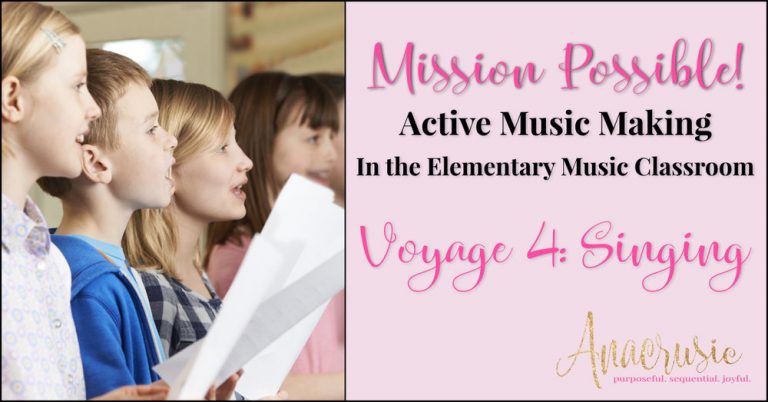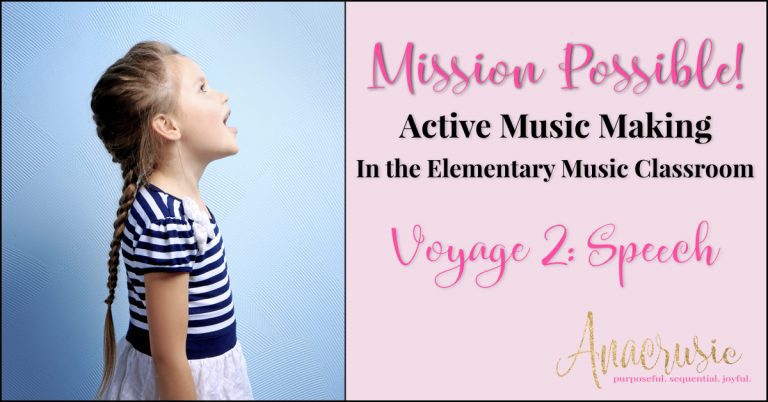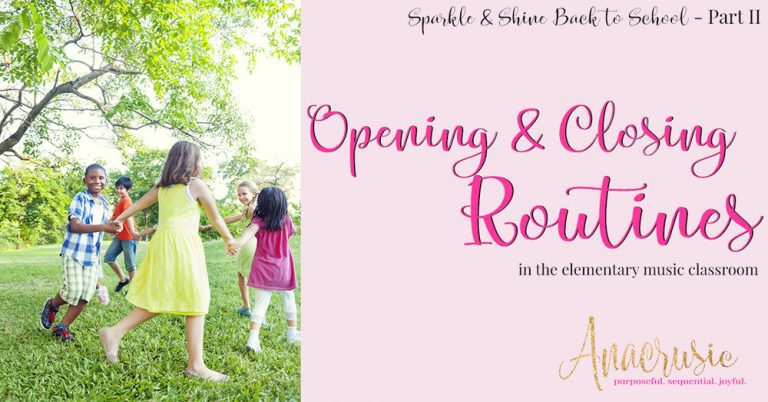Here we are almost through the whole month of April and on the second half of the Active Music Making Series! I hope that you’ve found some inspiration through these different blog posts to incorporate new ways of using different media in your elementary music room.
Today, we’re talking all about instruments—barred, drums, unpitched percussion, anyway you’d like to hit it (pun intended). This post will not identify the different ways to teach an instrumental piece, as if you were to open up your Orff & Keetman Volumes and teach it like the conductor of the orchestra (which, arguably, is not necessarily the way they intended in the first place…) However, today I’m going to be talking about different ways to use instruments to enhance musical experience within the context of any given learning sequence.
Overt Curricular Content
When teaching rhythmic concepts, using instruments in the music classroom is a fairly literal way to teach a concept. Whether students are in the preparation phase of learning where they are only tapping the way the words go or can read formal notation, using drums and other unpitched percussion provides a new (and fairly motivating) medium by which to explore and practice rhythmic concepts.
But aside from teaching ta and ti-ti on a hand drum, there are other ways to use rhythmic instruments as visual, aural, and kinesthetic exploration for students in the music classroom. And for melodic concepts as well. There is no better visual for teaching steps, skips, the pentatone, and other tonal patterns that barred instruments. Even if you aren’t speaking in terms of absolute pitch, seeing and working with concrete objects that show spatial relationships is an extremely valuable differentiation.
How to use it? Perhaps if you are singing an echo song, have students play their so-mi part on the barred instruments. If you’re practicing steady beat with Kindergarten, have them play a steady beat on the instruments on an open fifth or an octave. There are ways to add instruments in early on even with your itty bitties to get them holding mallets early on.
Engagement
Have you ever played an elimination game where after one kid is out, and then another, and then another, the class seems to get more and more and more chaotic? Yup. Been there, played that game. (Okay, that pun wasn’t totally intentional, but I think you get the point!) The key to avoiding chaos, or at least channeling it into controlled chaos, is to have a relevant task for kids to do when they are eliminated. This also gets rid of the Debbie Downer attitude for that one kiddo who has his whole day ruined by being the first one “out.” Geez, you might even have kids fighting over who got out!
Here are the three different ways I use instruments with a game, either for elimination, or having just half the class play (super useful if you’re pulling double classes or have groups of 25+):
- Keep the beat. I’m assuming that whatever game you are playing has a song or rhyme that goes with it, so in that case, have the students who are eliminated or not part of the playing half of the class keep a steady beat. This does not have to be on an unpitched instrument! It can be, but if the song is pentatonic, you can have kids keep a simple drone on do & so.
- Play the rhythm. This works best on unpitched instruments, particularly with kindergarten and first grade students. If you’re having them practice beat vs. rhythm, switch what they have to play on the rhythm sticks, drums, etc. with each round of game play.
- Play an ostinato. This is most effective for students who are in second grade or above, but have them write a simple one to two measure speech ostinato and then play it on unpitched percussion instruments.
Note: if you have a super advanced class, you could totally have them play the melody or compose a melodic ostinato, but both of those take much more time and attention on your part, and is a pretty big project in and of itself. These activities are meant to be more spur of the moment to keep everyone engaged. They are also pretty awesome formative assessment opportunities!
Improvisation & Composition
These two late practice/extension activities are great instrument applications. Whether you are doing melodic improvisation and composition, sequencing from speech to instruments is a fantastic way to facilitate indpendent musicianship in the elementary music room.
I wrote about a full composition sequence here but to start out, have students create a simple ostinato to go with a familiar folk song or chant. It can be played on barred instruments or unpitched percussion. Give examples, try lots of different students’ ideas, and get your kids comfortable exploring with this media.
Large Scale Form
Last, but not least, you can use instruments to extend learning, to create a large scale form or class rondo. I often turn to instruments when I want to create a more impactful piece for students to share at a performance or for the ending of a unit. If kids are working on a speech piece, transfer it to instruments. If they are working on a body percussion piece, transfer it to hand drums. If they are working on a folk song, add a drone and a simple ostinato. Then find different combinations and patterns that you can use to create a unique musical experience for your kiddos… even if it’s from a folk song.
A Final Word…
I’m sure there are a few readers who are thinking, I could never do these types of activities with my kids. And maybe that’s true. Maybe you can’t do these types of activities… yet. It all goes back to developing rules and procedures so your kids know what to expect. Also, the more you find ways to use instruments (or any of the media in this series!) frequently in the classroom, the more they will become accustomed to “how music class works” with instrument activities, because it will be practiced. Everyone has to start somewhere, so find an accessible entry point and dive in!
Don’t look at instrument pieces or activities and books and think that you can’t use it just because you can’t use it as is. Everyone’s classroom is different, everyone’s kids are different, and so there is no one size fits all. If you are wanting to being using instruments in the classroom, find a simple way to start that seems accessible for your kiddos. Then slowly turn up the volume as time goes on. You don’t need to take things verbatim, just use the inspiration.
Here’s what’s coming up next! This series is all about giving you not only motivation, but tools and concrete steps to begin slowly releasing control and giving your students more agency in the elementary music classroom. Here’s a peek at what’s coming:
- April 3: Introduction
- April 10: Voyage 1 – Movement
- April 17: Voyage 2 – Speech
- April 24: Voyage 3 – Instruments (That’s today, y’all!)
- May 1: Voyage 4 – Singing
Get ready to activate your music classroom and stop simply covering concepts. We’re about to level up, friends!




